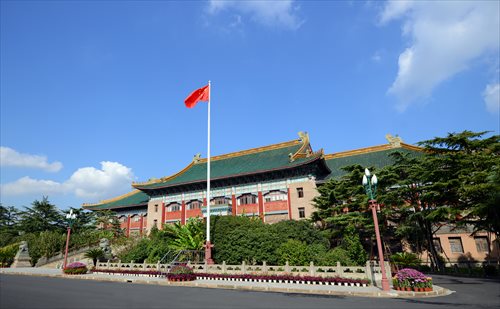

Lüwa Building at Shanghai University of Sport Photo: Courtesy of the university
Lüwa Building
Chinese palatial architecture is a common sight in large, old northern cities such as Beijing and Xi'an, but rarely seen in the south. This is true of Shanghai, whose historical architecture consists mostly of Western-style villas and shikumen houses.
But at Shanghai University of Sport, people can enjoy the beauty of a Chinese palace modeled on the style of the Qing Dynasty (1644-1911). Covering some 6,000 square meters, the palatial building (pictured below), with a roof covered with green glazed tiles and a facade painted with colorful patterns, was completed in 1933 as the headquarters of Shanghai Special Municipal Government.
"The construction of the building was an important part of the Great Shanghai Plan," said Xiong Xiaojian, a staff member at the school's publicity department. The plan was drawn up by the Kuomintang government of the Republic of China in 1927, which intended to build a new downtown area for the city in today's Yangpu district. "The old downtown districts were occupied by foreigners as concessions at that time," Xiong added.
In April 1935, the local government held China's first-ever group wedding ceremony at its headquarters, where more than 50 couples took photos in front of the gorgeous building.
"That day, lots of local residents gathered to watch the grand ceremony, and even famous foreign film companies such as MGM and Paramount came to cover it," Xiong said.
The Great Shanghai Plan was later interrupted by the Japanese invasion in 1937, and the building was severely damaged during the war. In the 1950s, when Shanghai University of Sport was relocated to Yangpu district, the building was repaired and used as an office building of the school.
"Now we call it 'Lüwa Building,' as 'lüwa' means green roof in Chinese," Xiong said. Inside the building, a map of Shanghai in the 1930s is carved on the floor, giving a glimpse into how the city looked back then.
Add: 399 Changhai Road
长海路399号
Copyright ©1999-2018
Chinanews.com. All rights reserved.
Reproduction in whole or in part without permission is prohibited.